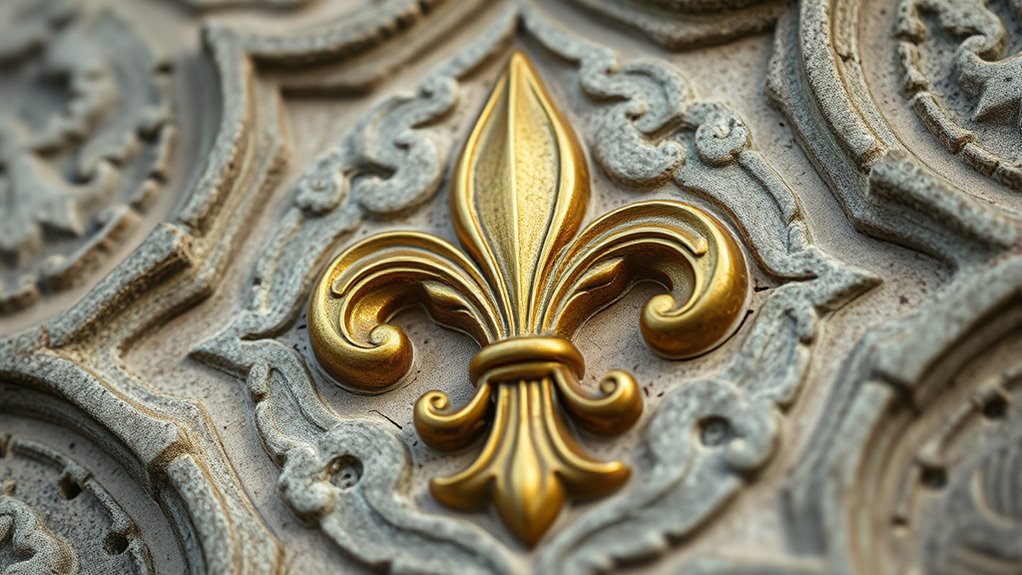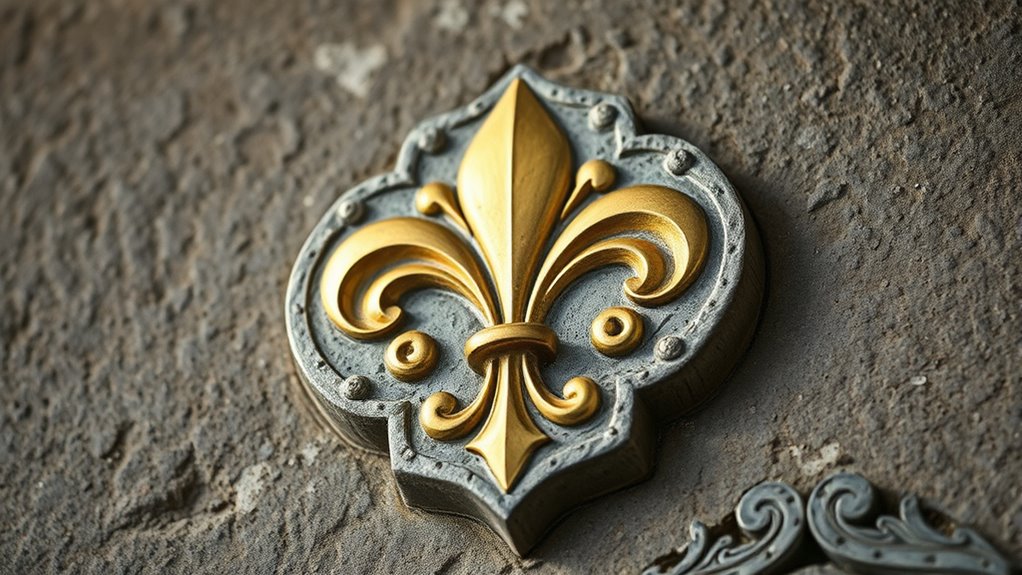The fleur-de-lis is a historic symbol rooted in medieval heraldry, often associated with royal authority, purity, and divine right. You’ll see it in coats of arms, flags, and architecture, especially in France and across Europe. Its elegant design symbolizes nobility and virtue, reflecting themes of power and legitimacy. If you look further, you’ll discover how this emblem continues to influence art and symbols of sovereignty today.
Key Takeaways
- The Fleur-de-Lis originated in medieval heraldry, symbolizing divine authority, purity, and sovereignty, especially in French royal tradition.
- It became a prominent emblem representing lineage, allegiance, and social status during the Middle Ages.
- The symbol was widely used in art, architecture, and royal seals to emphasize nobility and divine right.
- Its elegant, symmetrical design reinforced its association with virtue, chastity, and royal legitimacy.
- Today, the Fleur-de-Lis continues to symbolize tradition, nobility, and historical grandeur in various decorative arts.

Have you ever wondered about the origins of the elegant symbol known as the fleur-de-lis? This iconic emblem has a rich history rooted in medieval symbolism and royal heraldry, and understanding its significance helps you appreciate its enduring influence. In the Middle Ages, symbols like the fleur-de-lis weren’t just decorative; they carried deep meanings, often representing divine authority, purity, and sovereignty. During this period, it became a prominent motif in medieval heraldry, where coats of arms and banners displayed various symbols to signify lineage, allegiance, and status. The fleur-de-lis, with its stylized lily form, emerged as a powerful symbol of royalty, especially in France, where it became a national emblem.
The fleur-de-lis symbolizes divine authority, purity, and royalty in medieval heraldry and French national identity.
In the context of medieval symbolism, the fleur-de-lis was more than just a pretty design. Its shape is often associated with themes of purity and virtue, linked to the Virgin Mary, making it a fitting symbol for divine right and kingship. The lily itself, historically a symbol of chastity and innocence, was adopted by monarchs to emphasize their divine right to rule. When it appeared in royal heraldry, it signified legitimacy, authority, and the divine favor bestowed upon kings and queens. The use of the fleur-de-lis in heraldic devices was a deliberate choice to communicate these qualities to allies, subjects, and enemies alike.
Throughout history, the fleur-de-lis’s role in royal heraldry cemented its status as a symbol of power. French monarchs, in particular, adopted it as a badge of sovereignty, embedding it into royal seals, flags, and armor. Its elegant, symmetrical design made it recognizable and memorable, reinforcing the idea of stability and divine right. Over time, the symbol extended beyond France, appearing in various European coats of arms and decorative arts. Its association with nobility made it a popular motif in medieval art and architecture, often used to adorn religious artifacts, royal garments, and ceremonial objects, further emphasizing its connection to divine authority and noble virtue.
Today, the fleur-de-lis continues to evoke notions of tradition, nobility, and historical grandeur. Its roots in medieval symbolism and royal heraldry give it a timeless quality, reminding you of a period when symbols were powerful tools to convey legitimacy and divine blessing. Whether seen on coats of arms, architecture, or decorative art, the fleur-de-lis remains a potent emblem that captures the grandeur and authority of its storied past.
Frequently Asked Questions
How Has the Fleur-De-Lis Influenced Modern Fashion Design?
You’ll notice the Fleur de Lis shaping modern fashion trends through its elegant, timeless design. Designers incorporate it as a symbol of sophistication, often using it as a motif for modern couture embellishments. It influences everything from jewelry to clothing patterns, adding a regal touch. The Fleur de Lis’s historical charm continues to inspire contemporary styles, making it a popular choice for those seeking a classic yet fashionable statement.
Are There Any Variations of the Fleur-De-Lis in Different Cultures?
Yes, there are cultural adaptations and symbolic variations of the fleur-de-lis in different cultures. You’ll find it in French heraldry, but also in Japanese family crests and Indian motifs. These variations adapt the symbol’s elegance and meaning to local traditions, often emphasizing different qualities like purity, royalty, or spiritual significance. Exploring these cultural adaptations helps you see how a single symbol can evolve across diverse cultural contexts.
What Are Some Notable Buildings Featuring the Fleur-De-Lis Motif?
The fleur-de-lis blooms across historic architecture, standing as a royal emblem carved into stone and metal. Notable buildings like the Château de Versailles in France showcase this elegant motif, symbolizing monarchy and power. You’ll find it gracing facades, gates, and stained glass, adding regal charm. Its timeless presence weaves a thread of nobility and tradition, making these structures feel like living monuments to history’s grandeur.
How Is the Fleur-De-Lis Used in Contemporary Corporate Logos?
You’ll notice that the fleur-de-lis is used in contemporary branding symbols to evoke elegance, tradition, and authority. Companies incorporate it into their logos to tap into historical significance and timeless design trends. By doing so, they create a sense of prestige and trustworthiness. This motif’s versatility helps brands stand out, blending classic symbolism with modern aesthetics, making it a popular choice for brands aiming to convey sophistication and heritage.
What Symbolism Does the Fleur-De-Lis Hold in Military Insignia?
You’ll find that in military insignia, the fleur-de-lis symbolizes medieval heraldry and royal symbolism, representing honor, loyalty, and tradition. It often signifies a connection to historic monarchies, especially France, and is used to honor distinguished service. When you see it on insignia, it highlights a unit’s heritage, valor, and commitment to noble ideals, making it a powerful emblem of honor rooted in centuries of royal symbolism.
Conclusion
As you now see, the fleur-de-lis is more than just a symbol; it’s a timeless emblem woven into history and art. Its elegant curves whisper stories of royalty, faith, and tradition, standing tall like a lily reaching toward the sky. By understanding its rich symbolism, you can appreciate how this emblem continues to inspire, evoke, and adorn—reminding us that beauty and meaning often bloom from the simplest of forms, forever rooted in our collective imagination.











